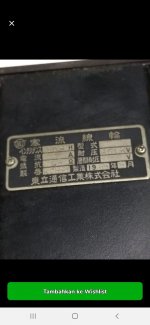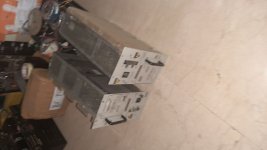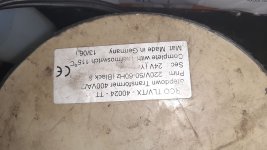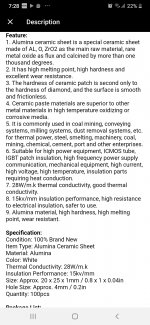Thats very useful, thanks for that ZM!
Question, with 1.5V se input, how much output will the mofo give on a 16ohm driver?
Question, with 1.5V se input, how much output will the mofo give on a 16ohm driver?
lets say that there are no losses and 1V5 on input is fully transposed to output
1V5 is presumably RMS
power is Urms^2/Rload
so 1V5^2/16=140mW
for Rick , with 7V , without Iron gain (using 600:600 strictly as Bal/SE converter) , it'll be 49/16 or 49/8 , depending what's driver impedance
with 6db of iron gain , swing is rougly 14V , so plethora of cojones - 14^2/16 (or 8)
1V5 is presumably RMS
power is Urms^2/Rload
so 1V5^2/16=140mW
for Rick , with 7V , without Iron gain (using 600:600 strictly as Bal/SE converter) , it'll be 49/16 or 49/8 , depending what's driver impedance
with 6db of iron gain , swing is rougly 14V , so plethora of cojones - 14^2/16 (or 8)
Dear ZM (aka the Magnificent One),
Thanks for your counsel.
I really did not want to deal with the buffers, damnit!!!
So now I am thinking that maybe I forget about the balanced bit and just go with the M2 autoformer scheme which i suspect you think superior anyway?
May I make it simple and BEG - what would ZM do? (The question every DIY audio kook is always asking themselves)
In case you were wondering, and I doubt you were, my driver is about eight ohms DCR - with a 20R resistor in parallel.
I was worried that lowering the capacitance could interact with the amplifier in a bad way. I know our fearless leader, when I was using around 0.15uf on the input of SIT1 said that was close to bringing about instability. I never heard any but raised the value to the current one in response,
Someone had mentioned, I think it was the wise fellow with the devil as his moniker that there was interaction with the output cap value and the inductor. I wanted to be sure I would not run into that!
The one question you did not address was the +/- 12 volts power supply versus a simple 24 volts - any advantage at all?
Would you give an SMPS a try here or would you use a linear? I like the fact that the SMPS would make it easy and as you know I like it easy if at all possible.
The lower voltage SMPSs have lower voltage ripple than the higher voltage ones. Not enough to make a great difference but I was wondering how would the two supplies (if one used two 12 volts supplies) interact - would you get the benefit of the lower ripple of the 12 volts supply or would the errors add and you end up where you would have been with a 24 volts supply of the same make and series?
I know you do not like follow up questions ...
THANKS and take care,
Thanks for your counsel.
I really did not want to deal with the buffers, damnit!!!
So now I am thinking that maybe I forget about the balanced bit and just go with the M2 autoformer scheme which i suspect you think superior anyway?
May I make it simple and BEG - what would ZM do? (The question every DIY audio kook is always asking themselves)
In case you were wondering, and I doubt you were, my driver is about eight ohms DCR - with a 20R resistor in parallel.
I was worried that lowering the capacitance could interact with the amplifier in a bad way. I know our fearless leader, when I was using around 0.15uf on the input of SIT1 said that was close to bringing about instability. I never heard any but raised the value to the current one in response,
Someone had mentioned, I think it was the wise fellow with the devil as his moniker that there was interaction with the output cap value and the inductor. I wanted to be sure I would not run into that!
The one question you did not address was the +/- 12 volts power supply versus a simple 24 volts - any advantage at all?
Would you give an SMPS a try here or would you use a linear? I like the fact that the SMPS would make it easy and as you know I like it easy if at all possible.
The lower voltage SMPSs have lower voltage ripple than the higher voltage ones. Not enough to make a great difference but I was wondering how would the two supplies (if one used two 12 volts supplies) interact - would you get the benefit of the lower ripple of the 12 volts supply or would the errors add and you end up where you would have been with a 24 volts supply of the same make and series?
I know you do not like follow up questions ...
THANKS and take care,
I did a comparison between the 19V and 12V version of the Mofo. I give preference to the 12V version with a bias of 2.2A and loads up to 6Ohms
Dear ZM (aka the Magnificent One),
Thanks for your counsel.
I really did not want to deal with the buffers, damnit!!!
So now I am thinking that maybe I forget about the balanced bit and just go with the M2 autoformer scheme which i suspect you think superior anyway?
May I make it simple and BEG - what would ZM do? (The question every DIY audio kook is always asking themselves)
In case you were wondering, and I doubt you were, my driver is about eight ohms DCR - with a 20R resistor in parallel.
I was worried that lowering the capacitance could interact with the amplifier in a bad way. I know our fearless leader, when I was using around 0.15uf on the input of SIT1 said that was close to bringing about instability. I never heard any but raised the value to the current one in response,
Someone had mentioned, I think it was the wise fellow with the devil as his moniker that there was interaction with the output cap value and the inductor. I wanted to be sure I would not run into that!
The one question you did not address was the +/- 12 volts power supply versus a simple 24 volts - any advantage at all?
Would you give an SMPS a try here or would you use a linear? I like the fact that the SMPS would make it easy and as you know I like it easy if at all possible.
The lower voltage SMPSs have lower voltage ripple than the higher voltage ones. Not enough to make a great difference but I was wondering how would the two supplies (if one used two 12 volts supplies) interact - would you get the benefit of the lower ripple of the 12 volts supply or would the errors add and you end up where you would have been with a 24 volts supply of the same make and series?
I know you do not like follow up questions ...
THANKS and take care,
- my experience is that balanced is beneficial only if you have it all the way , from source to amp (OK , Aleph J applies too, having proper bal input , even if OS isn't bridged) , under condition that you prefer sound of bal vs SE (usual distinction 2nd harmonic (SE) vs. 3rd harmonic dominance (Bal/bridged)
so , you have mainly SE input amplification , I believe , while you have Bal source ; make somewhere Bal to SE conversion , earliest you can , before having all xovering in place
+/-12V supply - naah ........ logical and worthy only if you're doing it to get DC coupled amplifier ; in this case that's not possible , so why bothering with doubling trouble ? with one rail you can always predict things , but with two rails in addition , prediction is not easy
switcher supplies - use them if you like them or simplicity you have with them; me - I'm cheapskate , so always resorting to what I have , or I can have for less greenies ....... or just get with less hassle ; so , cheapskate and lazy
follow up questions aren't problem ; too many questions at once can be , in case when answers are somewhat trickier than expected
...the +/- 12 volts power supply versus a simple 24 volts - any advantage at all?..
I can not think of any. This is naturally a 3-pin amp. You have to have power and signal commoned.
And 24V on 8 Ohms suggests a VERY large heatsink.
PRR,
I've been pondering your post regarding lowering the Ciss, and so I went looking, and found the IRF140 IRFP140NPBF Infineon Technologies | Discrete Semiconductor Products | DigiKey, which has Ciss~1400pF and transconductance~11.
What kind of modifications would we need to make to hit a similar sweet spot as the IRF250?
Kind regards,
Drew
I've been pondering your post regarding lowering the Ciss, and so I went looking, and found the IRF140 IRFP140NPBF Infineon Technologies | Discrete Semiconductor Products | DigiKey, which has Ciss~1400pF and transconductance~11.
What kind of modifications would we need to make to hit a similar sweet spot as the IRF250?
Kind regards,
Drew
Thanks for the guidance.
Was planning on using a large heatsink but will reconsider the use of 24 volts supplies.
I do think in this range I would prefer the sound of single ended and it is not as if I am having a noise problem using the SIT1s - there is only a little noise with one's head in the horn.
I have been using nothing more than a single ended cable from the DSP to the amplifier - the typical connection for such a thing. ZM are you suggesting some kind of transformer at the DSP?
I guess the space savings is the main advantage of the SMPS. I will most likely use on hand parts to make a linear supply.
Thanks, again,
Was planning on using a large heatsink but will reconsider the use of 24 volts supplies.
I do think in this range I would prefer the sound of single ended and it is not as if I am having a noise problem using the SIT1s - there is only a little noise with one's head in the horn.
I have been using nothing more than a single ended cable from the DSP to the amplifier - the typical connection for such a thing. ZM are you suggesting some kind of transformer at the DSP?
I guess the space savings is the main advantage of the SMPS. I will most likely use on hand parts to make a linear supply.
Thanks, again,
I understood that DSP is last box in front of multiple amps ;
for further comments ,, I would need some data , as Rout and swing/per phase , of DSP , same as desirable gain increase for each amplification subchain
for further comments ,, I would need some data , as Rout and swing/per phase , of DSP , same as desirable gain increase for each amplification subchain
is-it a DCX2496?
for compression drivers you can replace the choke with a light bulb or resistor....
for compression drivers you can replace the choke with a light bulb or resistor....
ZM,
The dsp box is between DAC and amplifiers - it is my control center - I use it for level and polarity switching along with the usual stuff.
I have to add I was very skeptical of using one of these until I got them.
XILICA specifies 50R output impedance. I will ask them about
Sure I am losing something due to the plethora of opamps and ADCs and DACs, etc. but it more than makes up for that (for my hearing) with the ability to correct for room problems. The ability to delay in general and with the phase controls in specific places it pretty magical. I am always defending my use of this to the purists but I have to say with the XILICA in place I can hear polarity differences before I get back to my chair after changing a musical selection.
One is almost stuck having to use these when determined to have an overly complicated big system but I can only imagine since I have never used one before but they have obviously come a long way and they are useful to the music lover. The only downside is it does take a long time to truly understand how to use it. I have come up with a thousand different schemes from simple to complicated and as expected somewhere in the middle is best.
One figures one should use low order crossovers but one should not assume too much. I have found matching the crossover slopes shapoe for high and low pass sections is the key. Needless to say one cannot simply do this with the crossover control. One must use the filters with the crossover filter to get them to match. This, I think, is more important than obsessing over flat response - which you are never going to get anyway and if you did it would probably sound terrible but getting those crossover slopes as similar in slope/shape is, I think, an overlooked thing.
Of course, i am speaking of ACOUSTIC slope.
Another thing is one needs to look at the channels running together. When you think about it most stereo recordings are 50% mono (my guess). Seeing how the whole room loads up will surprise you. And usually please you.
Sorry to go off on a tangent.
I ordered some parts today so I will put the basic thing togehter an hear what happens going straight from the XILICA into the MOFO.
I ordered both the IRFP250 and 150 since there seem to be some who prefer the latter. Might as well find out for myself.
I will initially build one of SALAS's L Adapter supplies for the amplifier going for 18 volts B+.
Should have something working in a week or so.
THANKS again for the help.
The dsp box is between DAC and amplifiers - it is my control center - I use it for level and polarity switching along with the usual stuff.
I have to add I was very skeptical of using one of these until I got them.
XILICA specifies 50R output impedance. I will ask them about
Sure I am losing something due to the plethora of opamps and ADCs and DACs, etc. but it more than makes up for that (for my hearing) with the ability to correct for room problems. The ability to delay in general and with the phase controls in specific places it pretty magical. I am always defending my use of this to the purists but I have to say with the XILICA in place I can hear polarity differences before I get back to my chair after changing a musical selection.
One is almost stuck having to use these when determined to have an overly complicated big system but I can only imagine since I have never used one before but they have obviously come a long way and they are useful to the music lover. The only downside is it does take a long time to truly understand how to use it. I have come up with a thousand different schemes from simple to complicated and as expected somewhere in the middle is best.
One figures one should use low order crossovers but one should not assume too much. I have found matching the crossover slopes shapoe for high and low pass sections is the key. Needless to say one cannot simply do this with the crossover control. One must use the filters with the crossover filter to get them to match. This, I think, is more important than obsessing over flat response - which you are never going to get anyway and if you did it would probably sound terrible but getting those crossover slopes as similar in slope/shape is, I think, an overlooked thing.
Of course, i am speaking of ACOUSTIC slope.
Another thing is one needs to look at the channels running together. When you think about it most stereo recordings are 50% mono (my guess). Seeing how the whole room loads up will surprise you. And usually please you.
Sorry to go off on a tangent.
I ordered some parts today so I will put the basic thing togehter an hear what happens going straight from the XILICA into the MOFO.
I ordered both the IRFP250 and 150 since there seem to be some who prefer the latter. Might as well find out for myself.
I will initially build one of SALAS's L Adapter supplies for the amplifier going for 18 volts B+.
Should have something working in a week or so.
THANKS again for the help.
No. 3 will definitely work, provided you design a linear PSU based on it, with CRC, or even better RCRC, followed by a CapMx and more CRC.
Plenty of examples here on this forum.
Plenty of examples here on this forum.
View attachment 823003
View attachment 823004
View attachment 823005
Will this work?
6kg each side heat sink
it'll work
choke - slightly higher Rdc than I would like - but - if it's big enough to dissipate heat (2A^2*1R5=6W) , it'll do the job
heatsink - more than good enough , if I'm seeing right how huge they are
24Vac xformer , little on high side ( will most likely result in 24Vac *1.25=30Vdc
you need to keep dissipation in mosfet up to 50W , but only if you're using bespoke thermal interface and big heatsink
heatsink you have , so use either Keratherm from Store ( if buying somehwre else , take care to buy exact type - 86/62
there are some other ones , less costly , but much worse conducting heat
yes , you can use cap multiplier to shave 4 or so DC Volts , being closer to prescribed rail ....... again - strictly dissipation issue , not that Mosfet doesn't like higher voltage
Last edited:
Last edited:
- Home
- Amplifiers
- Pass Labs
- Build This MoFo!
